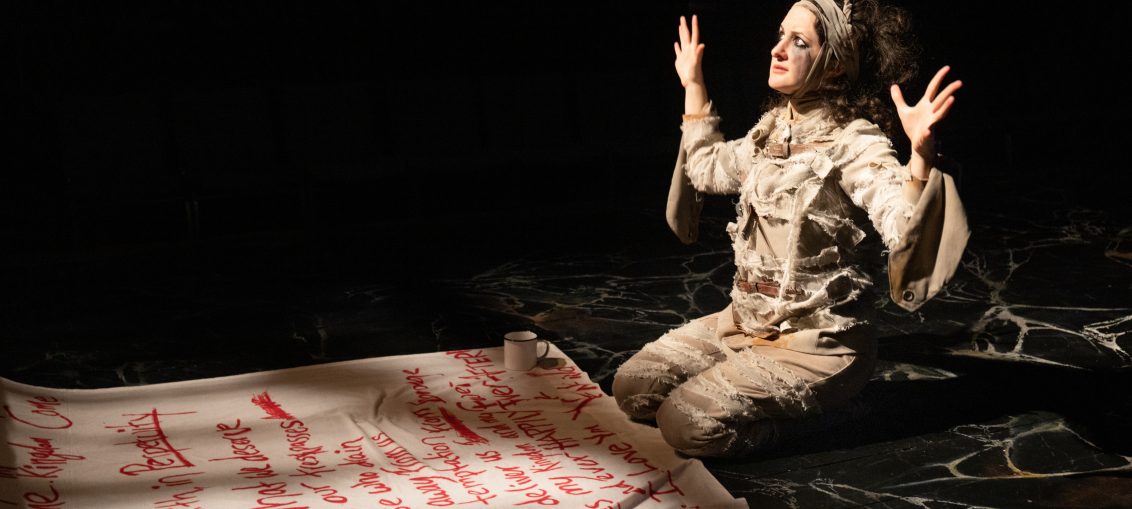
For as many adaptations and interpretations as there are of the classic gothic horror novels Frankenstein and Dracula, it is hard to imagine two more creative, unique, radical and timely works that deal with the well-known tales and characters than the pair playing in a repertory cycle at Classic Stage Company (CSC). They are also strikingly contrasting works. Both are deeply engaging, provocative and compelling explorations of the source material — each of which was written in the 1800s, one slightly predating the other near the end of the Victorian era. They remind the audience of timeless themes investigated in the books as seen through the eyes of contemporary playwrights — Tristan Bernays for Frankenstein and Kate Hamill for Dracula, respectively — who can’t dissociate themselves from the realities of our zeitgeist, and yet they do not bastardize the work by setting it in modern times. Instead, they honor the period but cast upon it the obscured view of current conflicts through the broken kaleidoscope of looming present-day issues: racism, sexism, misogyny, xenophobia, ignorance, paranoia, parasitic invasions, and God-complexes teamed with the eternal traits of the human condition such as loneliness, longing, vengeance, rage as well as determination, hope, redemption and the joy of true connection with another. Though different in prominent ways in their styles and choices, the two plays shared one major commonality in their themes: the real and more terrifying monsters were not the supernatural beings, but man (gender-specific) himself.
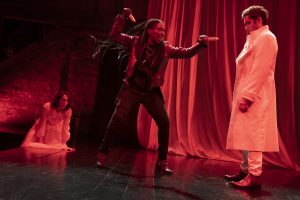
Race and gender figured heavily into both works and the casting choices were distinctive. For the intimate space with minimal props used for maximum effect, the audience in the U-shaped, almost round staging were very much a part of the show, and their reactions and responses to the actions in each play became an essential part of the stories. To that, credit must be given to the shrewd and sharp direction of Timothy Douglas (Frankenstein) and Sarna Lapine (Dracula). For pieces that are dependent on creating a suspension of disbelief to work and are employing minimal sets and props to portray the extremes of human (and inhuman) nature such as love, compassion, madness, terror, as well as encounters with the otherworldly, the subtle, yet spot-on lighting (Adam Honore) and sound designs (Leon Rothenberg) for both productions were exceptionally executed and painted the moods so richly that they bolstered the argument that one doesn’t need Broadway funding to create astoundingly effective theatre. Returning to the roots and the essentials may very well be the best bet — when the work and words are strong enough.
Both Frankenstein and Dracula were intriguing and exceptional in their own ways but so vastly opposite in their execution that it is hard, even unfair to compare. That’s what makes seeing them in repertory such a worthy venture. Even so, both had their particular virtues and drawbacks which may appeal more to some than others.
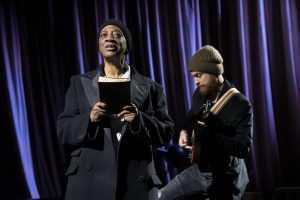
Frankenstein is a two-hander folk music-meets-poetry-meets-dialogue-meets-monologue piece. It feels like more of a work of performance art than a play in the traditional sense. Many forms are used to tell the story mostly from the monster’s point of view. Stephanie Berry is listed as The Creature/Victor Frankenstein, and the multi-character and multi-instrument playing Rob Morrison is merely referred to as The Chorus, as one would in Greek theatre. That is a shame because it undersells his ability as an actor, musical virtuosity and coverage of characters from Shelley’s novel as diverse and ranging as the blind man, Victor Frankenstein’s son and wife, as well as the doctor himself for a brief moment. Morrison opens the show by tuning vintage, stringed instruments like his pre-WWII design National resonator guitar and mandolin, as well as an 19th-century design Appalachian dulcimer which appeared almost elaborately “steam punk” in context. This non-essential to the plot activity was a great ice-breaker to indicate the show would be starting soon. Soon after, Berry took the stage and consumed it. She is surely one for whom a solo or duo setting works well because she commands a space with presence and poise, as well as patience. Her movements and explorations are unhurried and her face, bare and clean, not showcasing any monstrous special effects or even a dab of glamour, revealed a slightly weathered and extraordinarily expressive visage that made the hideous monster she claimed to be sympathetic, relatable and worthy of love and understanding as any other sentient being. Morrison’s haunting strings laid the foundation for Frankenstein’s creation’s longing to belong, to feel the human connection as Berry went through what I understood from comedy and improv classes to be a “clown exercise” — where a person essentially sees the world anew, as if through the eyes of a child. This is how the abandoned creature gained intelligence and humanity as it encountered nature and discovered language. Once a spoken word is established, there is a lot of room for play and Berry and Morrison bounce between monologue, dialogues, interaction with attendees, song and even a kind of slam poetry riff which Berry delivers with panache.
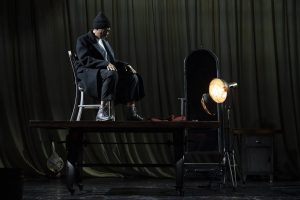
The most touching and powerful scene was between Morrison as the blind man whose family the creature has been studying and observing in its attempts to be human and educated itself in the ways of the world. When his grown children are away, Berry as the detestable being approaches, weary, petrified of being found out in its revolting form and banished from the family it had made its own in secret. But the blind man welcomes this stranger as a friend and embraces this new comrade, only to be discovered shortly thereafter by his horrified children who, upon return, witnessed their father gripped by a monster. To me, the strong visual representation of seeing this particular pairing on stage for the scene — a young white man and a middle-aged black woman (playing both man and monster) with shorn hair and masculine in presentation — was an excruciating, searing and all too true presentation of how black men (and some women) were and are still perceived in American society, as dangerous. The tenderness and sincerity of the connection between the creature and the blind man only to be torn asunder by the fear and ignorance of others to me hearkened back to America’s painful past of slavery (which would have been fully active when Shelley was first published, anonymously, in 1818). In a less extreme circumstance than if a blind father was hugging an actual-living dead monstrosity, the scene inspired me to think of what may have transpired, had such a thing happened with an Underground Railroad refugee or even an innocent dark-skinned person today who gets shot because of irrational fear instead of actual intention or clear motives.
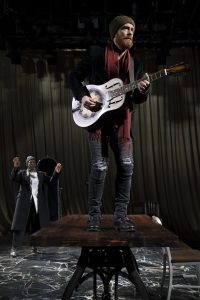
Berry brought a strong sense of underlying tenderness to Frankenstein’s creature that made it much more empathetic and brought the viewers deeper into its plights and sorrows. Instead of a horrifying monster, Berry’s interpretation was a bit more of a lovable lug akin to Lenny from Of Mice and Men, that is until the turn, the rejection. But after that point, the evolution ended and was replaced by a single-minded focus to enact revenge on the man who made it.
From that place of profundity and poignancy, Frankenstein became a bit meandering afterwards. There were strong moments and both performers gave it their all but it did feel as if the creators were trying to wrap up and cram a story they had taken their time with, into the last few key scenes of conflict between the monster and its maker. The revenge tales, deaths of the doctor’s loved ones and the subsequent chase across continents and into Antarctica were all relevant but lacked the level of emotional investment formed in the previous moments. The problem may have been that a piece that took its time in the beginning felt rushed in the end.
Contrastingly, Kate Hammill’s Dracula possessed practically perfect pacing that held strong and unwavering throughout the play which was longer than Frankenstein but somehow felt more succinct. Perhaps, the most significant difference was humor. Frankenstein took itself a bit too seriously and as a result came off as dour at times, whereas Dracula immediately informed the attendees that they’d be in for a good time and so they were and committed entirely to be along for the ride from the get-go, wherever it may lead.
This is all thanks to Hamill for two reasons: one — because her delightfully witty and wondrously rich writing, in both snappy dialogue and introspective soliloquy forms, and two — because of her character Renfield who acts as the wayward narrator of the tale and our guide to the dark side all from the confines of an asylum. Those familiar with Francis Ford Copolla’s star-studded film version with Gary Oldman in the title role from 1992 might recall a bizarre misfit portrayed by the marvelous, gravel-voiced storytelling musician and actor, Tom Waits. Now this Renfield is a Mrs., and one who was placed in a madhouse much like many wives were by their husbands who declared them “hysterical” but more likely than not who just wanted to be rid of them and were given full rights to do so. Not the case for Mrs. Renfield, he didn’t have the chance, for she was taken after he went missing and she was raving anti-religious statements and proclaiming “Our father is coming! Daddy is coming!” hinting at some serious Electra issues. Hamill introduced the play through this quirky and intriguing oddball, and thus the stage was set for plenty of mischief, mayhem and as much uproarious laughter as gasp and gore.
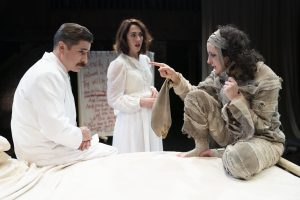
Hamill’s Dracula is so riotous, radical, enjoyable and inspiring that it could be seen and explored as an alternative bachelorette’s event or girls’ night out excursion for the high-brow, sophisticated modern woman and her cohorts seeking empowerment as much as action.
The storyline, for the most part, remains pretty faithful to the novel (no doubt thanks to dramaturg Kristin Leahey), save for a few noticeable strays — the gender-swapping and Mina’s (played with elegance and sincerity by Kelley Curran) baby bump. There have been so many versions and interpretations of Dracula that it can be hard to recall which one stays true to the novel (and many do not), but the choices Hamill made were bold and effective, none were arbitrary. Mina’s pregnancy made her both more vulnerable and weaker in body and the eyes of others (especially men) but much stronger in spirit and conviction. She’s protecting and defending not only herself and those she loves in the present but the very future no less. The other most notable variation from the original book was the character of Doctor Van Helsing. To give a cinematic visual representation: if it were given the Hollywood treatment, this Van Helsing — the vampire hunter — would have been portrayed not by someone such as Sir Anthony Hopkins but more akin to Danai Gurira in her full Walking Dead and Black Panther bad-ass, splendor. Hamill’s Doctor Van Helsing is played exquisitely by Jessica Frances Dukes. From the moment she saunters on stage with a leather jacket, low-heeled boots and a brimmed hat poised atop her dreadlocks which fly in every direction like a cat-o-nine-tails whip when she is engaged in battle or debate, it is impossible to take your eyes (or ears as she has the best lines) off her and she repeatedly steals the show. “What? You were expecting an old Dutch man?” she chuckles when met with disbelief. Her closer counterpart may be the Japanese manga/anime character Vampire Hunter D, who is as alluring as he is mysterious and whose devotion to the cause comes not from male ego, but a deep sense of purpose and awareness that monsters (be they myth or men) ought to be put down.
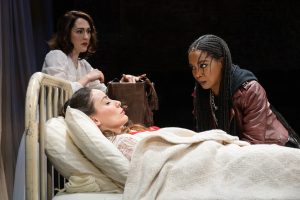
On that note, there are a lot of allusions to the #MeToo movement and the sobering facts (that are no doubt quite likely under-accounted for and were probably much worse in the era the book was first written) that one out of every four women in America has been the victim of rape. One in three is the common statistics for the looser terms of physical and/or sexual abuse of any kind. I would argue 95% or more for emotional abuse if not more with a margin of error. But the women of Hamill’s Dracula are not mere victims, even the ones who do die — the vampiric wives (Laura Baranik and Lori Laing, who also play the asylum orderlies) and Mina’s best friend Lucy (the charming Jamie Ann Romero) to the stake, to bloodsuckers and in the case of poor Mrs. Renfield (Hamill) to her own hand after being rejected by her master and father-figure, have significance to the play and stories to tell before they are wiped out. None of them are merely foil characters or tragic figures, their author has ensured that. In fact, it is the men who appear more one-dimensional and that — much like when white people find themselves in a theatrical situation where there is a “flattening of a white character” (as described by the remarkable dramatist Antoinette Nwandu) — might feel unsettling to some but it is really just a shift in the dynamics. It is a bit of a “flattening of the male”, but not the whole time, or for all males, and the men who play the roles do so with verve and flair as much as women have in perpetuity. The titular character of Dracula (performed delectably by Matthew Amendt) in his white suits and oxblood boots offered welcomed eye-candy and fulfilled the female fantasy of the sexy bad boy vampire, yet revealed his shortcoming with his melodrama, lies, disloyalty and obnoxious God-complex. Jonathan Harker, Mina’s husband (played by Michael Crane), is a meager and easily manipulated ‘nice guy’ with underlying ambitions and a cruel streak as leftover residue from his ancient master’s mind control. The one male role who gained sympathy and appreciation was Doctor Seward (beautifully explored by Matthew Saldivar), Lucy’s husband-to-be, who began as a pompous traditionalist and finally ended his life as an evolved man once he actually listened to the women’s wisdom.
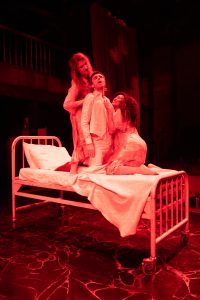
Filmmaker and actress Brit Marling (who co-wrote, created and stars in the Netflix series The OA) authored a brilliant and penetrating opinion piece in The New York Times called “I Don’t Want to Be the Strong Female Lead.” In it, she recounts her time auditioning for roles such as ‘’Dave’s wife, thin, attractive,” and “robot girl; her breasts are large and she is wearing a red sweater.” But while many of us who have seen those descriptions know that they are as ubiquitous as they are ridiculous, Marling goes a step further — the so-called “strong female leads” are not much better, as they still play to the male vision and fantasy of a woman only being strong if she is tough, hard, with “physical prowess, linear ambition, focused rationality”, yet all the while remaining highly desirable. Masculine modalities of power in a much prettier package — a perfect fantasy. Perhaps a bit better than big boobs robot bimbo but still a product of the patriarchy and devoid of what makes a woman both female and feminine — vulnerability, compassion, empathy, intuition, complexity, sensitivity, loving. And these are not just female traits belonging to those born or identifying as such but the other side of the scale of the hyper-aggressive and often toxic masculinity that is so pervasive in society. It’s a re-balancing act. And thank goodness (or goddess) that there are women like Marling and Hamill who have seen the issue, said “enough is enough” and instead of complaining have taken action that has ignited a fire that once lit, can only keep spreading.
It is not an overstatement to say that Kate Hamill is a national treasure and should be regarded as one. Driven by an unyielding passion to create new feminist, female-centric classics that center around complicated women, social and gender issues, her Dracula is just another nail in the gilded coffin to seal this unquestionable truth. She was named 2017’s Playwright of the Year by the Wall Street Journal and can also claim the honor of being one of the 10 most-produced playwrights in the country for 3 seasons running (2017-2020). Additionally, in both 2017-2018 and 2018-2019, she wrote two of the top 10 most-produced plays. Watching her works in action, it is easy to understand why — particularly to someone who used to do the former and now does the latter — they are both incredibly actable and producible. The mark of the works of great dramatists is that they stand the test of time but also reflect the era they were created in because they hold the perpetual mirror up to human nature. We may wear different garments and have smartphones and laptops but the root of people’s emotions and behaviors have not changed all that much. The Greeks and Shakespeare are still performed today everywhere to the big budgets of Broadway or the West End to in middle and high schools across the world. These plays were very much of their times down to political innuendo and yet they (if done well) do not feel dated but rather immediate. Hamill’s works are like that and this is why they rival such classics from hundreds and thousands of years ago — they are fun to act in, easy to put on, an absolute pleasure to witness and everyone gets a great role with some meat in it — there are special moments, backstories and dimensions to each part, leads or otherwise. Hers are not the work of a visionary auteur who is the only one who could stage such a thing and are so high concept or so high budget that they could only find a home in particular places. On the contrary, they are unpretentious, uncomplicated, manageable and best left that way to allow the words to sing and bring the spirit of true theatricality and suspension of belief back to the stage. This is why Hamill’s plays can be just as effective on or Off-Broadway as in a regional theater, or even a community theater or high school. Hamill creates works that are accessible, appeasing and appealing to the masses and yet are profound, insightful and potent. This is exactly the kind of engaging, enriching, empowering and inspiring theatrical work we need right now — all of us. The audience that ranged from grey-haired to college-aged or younger all left CSC chattering enthusiastically and grinning from ear-to-ear. Call it the Kate Hamilton Effect. Glad she went a little Gothic on this one for good measure.
Frankenstein and Dracula run in repertory at Classic Stage Company (136 E. 13th St, New York) through March 8, 2020. CSC 2019-20 season memberships are now available starting at $25. Single tickets and member tickets for Dracula and Frankenstein are now on sale. Tickets for Dracula and Frankenstein are $80 between February 18 and March 8. Special two-show packages offer one ticket each to Dracula and Frankenstein for $130. Prime seats are available at all performances for $125.Tickets and membership packages can be purchased at classicstage.org or 212.352.3101 (or toll free 866.811.4111).
 Friday, January 2, 2026
Friday, January 2, 2026